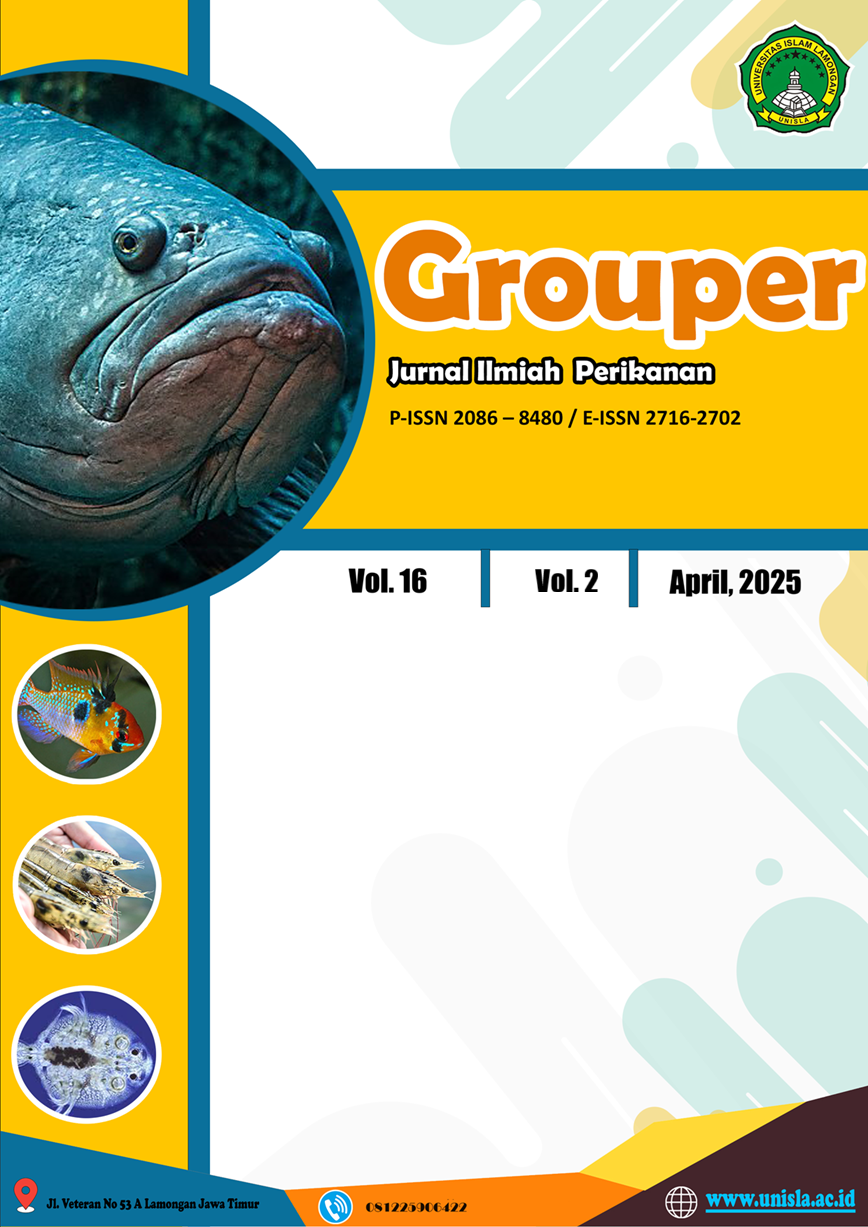Analysis of Volatile Component Profile of Bekasam Seluang Fish (Rasbora argyrotaenia
DOI:
https://doi.org/10.30736/grouper.v16i2.367Keywords:
Volatile, Bekasam, Seluang FishAbstract
Seluang fish is a freshwater fish commonly found in Southeast Asian waters, including Indonesia. Fermentation, autolytic and enzymatic degradation of protein and fat produce volatile compounds such as organic acids, carbonyls, nitrogen compounds, and sulfur. The research aims to analyze the identification of volatile compounds in bekasam seluang fish. The research was conducted at the Integrated Laboratory, Lambung Mangkurat University, Banjarbaru, using a four-treatment design and three replications, namely: O (without roasted rice), A (50% roasted rice), B (60% roasted rice), and C (70% roasted rice). Analysis of volatile components was carried out using Gas Chromatography-Mass Spectrometry (GC-MS), an instrumental technique for separating and identifying compounds in complex samples. Volatile components using GC-MS Headspace revealed that the addition of roasted rice affected the complexity of the volatile compounds formed. The higher the concentration of roasted rice, the more volatile compounds typical of fermentation were formed, such as pyrazine, methanol, methyl uronate, and isoleucinol. The 60% roasted rice treatment produced the most complex but balanced volatile compound profile, while 70% produced compounds with a strong aroma but potentially masked the characteristic aroma of fish.
Downloads
References
Amatullah, L. H., Afifah, D. N., & Jannah, S. N. (2023). Isolation and molecular identification of proteolytic bacteria from Rusip, an Indonesian fermented food. Biosaintifika: Journal of Biology & Biology Education, 15(3). https://doi.org/10.15294/biosaintifika.v15i3.42237
Candra, J. I., Zahiruddin, W., & Desniar. (2007). Isolasi dan karakterisasi bakteri asam laktat dari produk bekasam ikan bandeng (Chanos chanos). Buletin Teknologi Hasil Pertanian, 10(2), 14–24.
Desniar, I., Setyaningsih, R., & Fransiska, I. M. (2023). Perubahan kimiawi dan mikrobiologis selama fermentasi bekasam ikan nila menggunakan starter tunggal dan campuran. Jurnal Pengolahan Hasil Perikanan Indonesia, 26(3), 414–424.
Edirisinghe, J. P., Wierda, R. D., Fletcher, W. K., Xu, Y., & Dufour, J.-P. (2007). An SPME-GC-MS method developed to detect spoilage indicators of yellowfin tuna (Thunnus albacares). Journal of Chromatography A, 1147(1), 22–31. https://doi.org/10.1016/j.chroma.2007.02.047
Karki, T., Odjha, P., & Panta, O. P. (2017). Metaproteomic insights into fermented fish and vegetable products and associated microbes. LWT - Food Science and Technology, 80, 479–484. https://doi.org/10.1016/j.lwt.2017.03.022
Kemenkes RI. (2017). Data komposisi pangan Indonesia [Data online]. Jakarta: Kementerian Kesehatan RI.
Lapsongphon, N., Yongsawatdigul, J., & Cadwallader, K. R. (2015). Identification and characterization of the aroma-impact compounds in fermented fish seasoning prepared from Nile tilapia. Journal of Food Science, 80(12), C2736–C2744.
Lestari, M. W., Bintoro, V. P., & Rizqiati, H. (2018). Pengaruh lama fermentasi terhadap tingkat keasaman, viskositas, kadar alkohol, dan mutu hedonik kefir air kelapa. Jurnal Teknologi Pangan, 2(1), 8–13.
Lestari, M. W., Bintoro, V. P., & Rizqiati, H. (2018). Pengaruh lama fermentasi terhadap tingkat keasaman, viskositas, kadar alkohol, dan mutu hedonik kefir air kelapa. Jurnal Teknologi Pangan, 2(1), 8–13.
Menteri Kesehatan Republik Indonesia. (2019). Peraturan Menteri Kesehatan Republik Indonesia Nomor 28 Tahun 2019 tentang Angka Kecukupan Gizi yang Dianjurkan bagi Bangsa Indonesia.
Mulyani, S., Sunarko, K., & Setiani, B. E. (2019). Pengaruh lama fermentasi terhadap total asam, total bakteri asam laktat dan warna kefir belimbing manis (Averrhoa carambola). Jurnal Ilmiah Sains, 21(2), 113–118.
Nuraini, A., Ibrahim, R., & Rianingsih, L. (2014). Pengaruh penambahan konsentrasi sumber karbohidrat dari nasi dan gula merah yang berbeda terhadap mutu bekasam ikan nila merah (Oreochromis niloticus). Jurnal Saintek Perikanan.
Pinu, F. R., & Villas Boas, S. G. (2017). Rapid quantification of major volatile metabolites in fermented food and beverages using gas chromatography–mass spectrometry. Metabolites, 7(3), 37. https://doi.org/10.3390/metabo7030037 mdpi.com
Pratiwi, T. Y. (2014). Gambaran reproduksi ikan wader pari (Rasbora argyrotaenia) pada bulan Desember–Januari tahun 2013–2014 di Sungai Kaporan, Kecamatan Kraksaan, Kabupaten Probolinggo [Skripsi, Universitas Brawijaya].
Priyanto, A. D., & Djajati, S. (2018). Bekasam ikan wader pari menggunakan berbagai macam olahan berasa terhadap sifat mikrobiologi dan organoleptik. Jurnal Ilmu Pangan dan Hasil Perikanan, 2(2), 107–115.
Rahayu, P. W. (1992). Teknologi fermentasi produk perikanan. Balai Pusat Antar Universitas Pangan dan Gizi, Departemen Pendidikan dan Kebudayaan, IPB.
Ramadhanti, B. W., Sumardianto, & Romadhon. (2024). Karakteristik mutu dan kandungan senyawa volatil bekasam cumi-cumi dengan lama fermentasi yang berbeda. Jurnal Pengolahan Hasil Perikanan Indonesia, 27(3), 208–222.
Ravyts, F., Vuyst, L. D., & Leroy, F. (2012). Bacterial diversity and functionalities in food fermentations. Engineering in Life Sciences, 12(4), 356–367.
Ray, A. K., Ghosh, K., & Ringø, E. (2012). Enzyme-producing bacteria isolated from fish gut: A review. Aquaculture Nutrition, 18(5), 465–492. https://doi.org/10.1111/j.1365-2095.2012.00943.
Sudaryanti, Handoko, S., & Agus, S. (2023). Fermentasi bekasam ikan wader sebagai sumber belajar bioteknologi konvensional. BIOLOVA, 4(2), 114–120.
Downloads
Published
How to Cite
Issue
Section
License
Copyright (c) 2025 Herni Noormaliani, Yuspihana Fitrial, Agustiana

This work is licensed under a Creative Commons Attribution-NonCommercial-ShareAlike 4.0 International License.







.jpg)
1.png)



